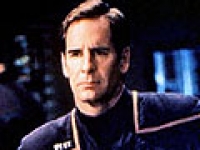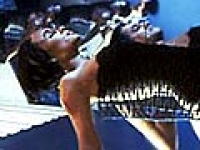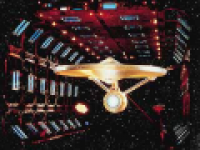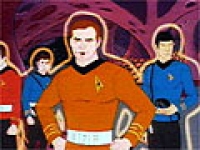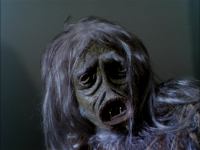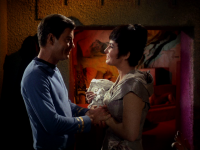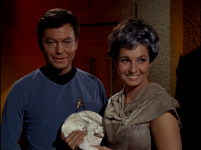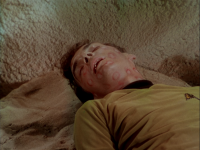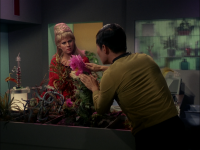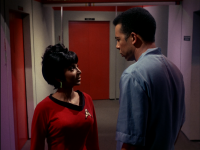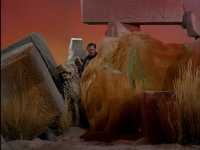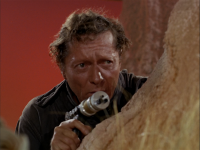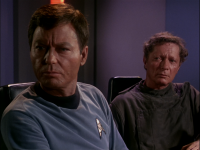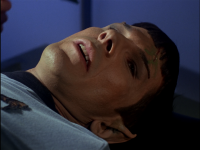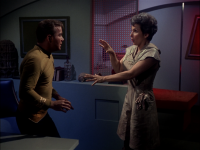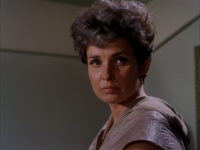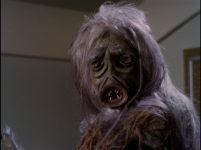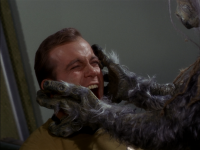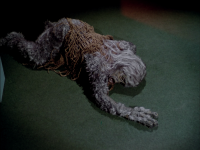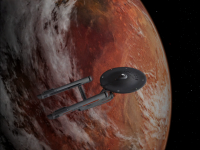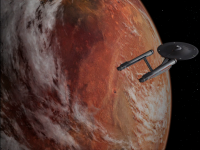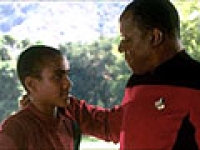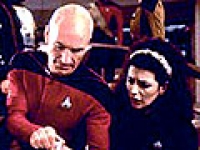Star Trek: Newest — 1x01 — Second Contact
Synopsis
Ensign Tendi has her first day of work on Starfleet's U.S.S. Cerritos, where she meets fellow support crew members, Ensigns Mariner, Boimler and Rutherford. Meanwhile, Boimler is tasked with a secret special assignment and Rutherford attempts to keep his dating life intact while a sci-fi disaster strikes the ship.
Remarkable scenes
- Mariner ridiculing Boimler for making a fantasy captain's log.
- Much of the crew suddenly turning into zombies.
- T'Ana discovering that the slime is the cure for the zombie infection.
- Boimler covering for Mariner.
Review
An animated comedy is a risky move for Star Trek. Star Trek has had a checkered past with animation. The 1970s animated series was mostly embarrassing, Star Trek: Discovery's "Ephraim and Dot" short was a mixture of pointless and canonically problematic, and Star Trek: Discovery's "The Girl Who Made the Stars" was reasonably well-made and charming but probably should've been incorporated into an actual episode of Discovery instead, since presenting it as a short makes it feel more like a deleted scene than a piece of its own.
When it comes to comedy, Star Trek has had a checkered past there as well, but less so. Some of Star Trek's most celebrated episodes are highly effective comedy, like TOS: The Trouble with Tribbles, TOS: Shore Leave, TNG: QPid, TNG: Hollow Pursuits, DS9: Looking for par'Mach in All the Wrong Places, DS9: Trials and Tribble-ations, Voy: Message in a Bottle, Voy: Tinker Tenor Doctor Spy, and Ent: In a Mirror, Darkly, not to mention Star Trek IV: The Voyage Home and of course countless funny scenes in countless episodes that were not primarily comedy episodes. Notably excluded from that list are episodes of Star Treks: Discovery and Picard though, which have delivered little to no effective comedy so far, which is harder to do with fully serialized dramas. Plus the older series had plenty of failed attempts at comedy peppered throughout their long runs too, so botched comedy is not a new phenomenon in Star Trek.
Star Trek: Lower Decks so far is no exception to that trend. Some of the comedy in this pilot episode is effective, some of it is not. Thankfully they didn't try to double down on the dreadful tone in the absolutely awful Star Trek: Discovery "The Trouble with Edward" short. While "The Trouble with Edward" and Lower Decks both draw comedy from characters behaving in awkward and at times reckless ways, "The Trouble with Edward" took it much too far, trying to present deadpan, vindictive cynicism as somehow a species of comedy as well whereas Lower Decks is more upbeat and goofy. Ensign Mariner—the standout character so far—is a screw the rules rebel not unlike Ensign Ro Laren from TNG, but more carefree about it like an even more unhinged Tom Paris from Voyager. The fact that she's serving aboard her own mother's starship in a remedial role adds even more fun texture to the premise of her character.
Boimler, Tendi, and Rutherford seem less interesting so far. Rutherford in particular was a bit of a head-scratcher given his presentation as a "recent cyborg" which isn't explained all that well. Why does he have that implant? Why does it randomly suppress his emotions? Are we really to believe that because the implant was made by Vulcans that it has that severe a side effect? Hopefully that's a plot point that will be expanded on and buttoned up better in the future. Another aspect of the comedy that is less effective is the continuation of Discovery's trend of overly contemporary and usually hyperactive delivery of dialog, making the characters seem positively manic at all times, as though the mania is the joke. Fast dialog can be used effectively for comedy (Bojack Horseman was excellent at this), but the content of the jokes has to be funny too. Often the fast dialog existed solely to deliver rapid fire references to previous episodes of Star Trek for longtime fans to pick apart and giggle about, like "haha, she's talking about Martok!" The references are certainly amusing on a mostly banal surface level, but we need more than that.
That said, the references to previous Star Trek series do run pretty deep in places too. There are countless tasteful and well-placed visual and audio callbacks to old series, the most impressive being the setting and set designs. When Boimler fantasizes about being captain in his log entry, he cites the stardate as 57436.2, which translates to roughly the year 2380, about a year after Star Trek X: Nemesis and roughly 20 years before Star Trek: Picard. The visual design of the Cerritos, the starbase, and just about everything we see embeds this series perfectly in that era to a degree of accuracy that has a surprising amount of attention to detail, a sharp departure from the "visual reboot" trend we've seen recently. The computers have the LCARS design, the holodeck looks like TNG's, the ship design looks plausibly like TNG-era ships, the warp effect has been restored to the beautiful star flybys instead of the hideous hyperspace effect we get in Discovery and Picard, etc, there are too many examples to list. They even brought back the font from TNG.
It's worth noting that people so often complained about how the original series and TNG visual designs looked "dated" thus justifying Discovery's and Picard's visual reboot, but Lower Decks does much to undermine that notion. For example, Discovery and Picard didn't just take the original series' jelly bean button computers or TNG's LCARS displays and add more detail, they morphed them into a considerably less plausible "movie OS" holographic display that would be an ergonomic nightmare for anyone to actually use for serious work. It may look flashier on TV, but it's less realistic than the interfaces presented on both TOS and TNG, just as the Discovery/Picard hyperpsace-style warp effect is less realistic than the old stars flying by warp effect from TNG. In this sense, Discovery's and Picard's visual reboot is only "modern" in the sense that their aesthetics are currently trendy, not because those aesthetics are actually better. They're dumb fads, not improvements. Lower Decks, Ent: In a Mirror, Darkly before it, and Rogue One from the Star Wars universe have each shown us it's entirely possible to add a bit more detail to previous, timeless aesthetics to make them look more modern instead. That's the most updating the visuals ever needed. If only Star Trek: Discovery and to a lesser extent Picard treated canon with as much care as this silly comedy show does.
All things considered, while this may be a silly comedy show, it's an unexpectedly effective one. The writers would do well to pivot the comedy more in the direction of the smarter, subtler comedic style and tone seen in Futurama or The Orville rather than making it so reminiscent of Rick and Morty slapstick, but by and large this show works surprisingly well as-is and so far is a welcome and promising addition to the canon.
Star Trek: Newest — 1x01 — Remembrance
Synopsis
At the end of the 24th Century, and 14 years after his retirement from Starfleet, Jean-Luc Picard is living a quiet life on his vineyard, Chateau Picard. When he is sought out by a mysterious young woman, Dahj, in need of his help, he soon realizes she may have personal connections to his own past.
Remarkable scenes
- Seeing the Enterprise-D again in Picard's dream about Data.
- Picard: "The dreams are lovely. It's the waking up that I'm beginning to resent."
- Picard having a more hostile interview than he expected, then going off on a rant about how Starfleet has lost its way after the attack on Mars and the destruction of Romulus.
- Picard finding Dahj's image in one of Data's old paintings; painted before she was born.
- Dahj sacrificing herself to save Picard just as Data did.
- Picard: "I haven't been living. I've been waiting to die."
- The Romulans taking up residence inside the wreckage of a Borg cube.
Review
In TNG: All Good Things, the closing line is from Picard saying, "Five card stud, nothing wild, and the sky's the limit." In Star Trek: Picard, we pick up where he left off with the opening lines from Picard: "See. And raise." And Data: "Hmm. Call." The opening song is "Blue Skies," mirroring the same song closing Star Trek X: Nemesis. Data performed it in Nemesis and his brother B4 began to sing it at the end of the film as a clue that Data's attempt to transfer something of himself to B4 might have succeeded.
Now decades have passed. Picard isn't as sharp as he once was. Or as nimble. He is sometimes loopy and meandering. His once signature drink has transitioned from "Tea, Earl Gray, Hot," to "Tea, Earl Gray, Decaf." He's a sleepy figure both figuratively and literally. He drifts in and out of consciousness and his engagement with the present moment similarly wavers. His mind wanders to days gone by and it free associates between dangling thoughts, feelings, memories, and regrets.
Like the laundry list of dangling threads of Picard's life that his mind drifts to, the 24th century itself was never buttoned up as cleanly as Star Trek fans might've preferred. Star Trek: Picard sets out to course correct that on many levels by working a series of loose ends from previous stories into a new story that adds yet more depth to the already rich character of Picard and resumes the truly stellar world building of 24th century Star Trek that wound down with a whimper leaving so many questions unanswered at the conclusion of Voyager along with the airing of Star Trek X: Nemesis and Star Trek XI (2009).
Geopolitical disaster and national tragedy have now led the Federation to become fearful, tribal, and nationalist. Decades of these politics apparently consuming the Federation to some degree have caused Picard to become disillusioned with Starfleet itself, which he believes has lost its way. While it would've been nice if the story spent more time unpacking the political situation (that interview went by way too fast!), what appears to be going on is a decision was made at the highest levels to abandon a project to rescue hundreds of millions of Romulans from Romulus on the eve of its destruction from the supernova Spock told us about in Star Trek XI (2009). This errand of mercy was called off after an attack on Mars carried out by a group of androids destroyed a large chunk of the planned rescue fleet and killed tens of thousands of Federation citizens, including presumably the parents of the children seen in the previous episode Children of Mars.
It isn't terribly clear why the sentiment that the Federation shouldn't try to redouble its efforts to save as many lives as possible became so popular, but this retrenchment disgusted Picard, who resigned from Starfleet in protest. He then became a public symbol of dissent from what is presumably a relatively popular anti-foreign aid political attitude among a broad swath of Federation citizens, thus the confrontational tone during the interview. Plus Picard's long friendship with Data further smeared his public image in the minds of Federation nationalists committed to Othering androids, who pushed for a ban on their entire existence and succeeded in getting it enacted by the Federation legislature.
This is a much better approach to critically examining the rise of nationalist tribalism in the real world's early 21st century through allegory on Star Trek than Discovery's clunky first season was with the Klingons desiring to "remain Klingon." Aside from the fact that it leverages canon directly in smart ways unlike Discovery which stumbled through canon making a mess as though it were in a drunken stupor, the idea of portraying the Federation itself as flirting with reactionary politics is both chilling and an eerily familiar extension of hints the story had already given us in previous series. It was established already that the Federation previously banned genetic engineering in the same reactionary manner that creating android life has now been banned. The wisdom of this ban too has been questioned in the story, though not nearly as forcefully as it ought to have been. DS9 examined it a bit through the lens of illegally genetically enhanced Dr. Bashir, but the best exploration of it arguably came from Enterprise's 4th season's "augments" arc.
Recall the following conversation between Dr. Arik Soong—an ancestor of Data's inventor Dr. Noonian Soong—and Dr. Phlox in Ent: Borderland. Soong: "I didn't realize you shared humanity's reactionary attitude toward this field of medicine." Phlox: "On the contrary, we've used genetic engineering on Denobula for over two centuries, to generally positive effect." This line implicitly admits that genetic engineering—if properly regulated like most technologies—can be a net positive to society. Later in Ent: Cold Station 12, Archer laments that the ban on genetic engineering was the ultimate cause of his father's death, who died of a disease that genetic engineering could've cured. Archer and Phlox muse that maybe Dr. Soong had a point, but conclude that the ban was sensible because humanity's instincts hadn't caught up with its intellect.
But it turns out Dr. Soong did have a point. Now this reactionary attitude towards technology or perhaps towards change itself has come for Arik Soong's progeny's life's work as well: androids. And it of course remains to be seen whether or not sentient holograms will be caught up in the reactionary anti-artificial life fervor too. Whither Voyager's doctor? And for that matter, were the other EMH Mark I holograms we saw in Voy: Author, Author ever granted humanoid rights like Data too? While it's certainly true that humanity's instincts haven't caught up with its intellect if reactionary politics are winning the day, the right answer isn't Archer's and Phlox's resignation to the status quo. The right answer is Picard's staunch resolve to defeat the reactionaries. To reclaim the Federation and Starfleet for the cause of exploration, scientific inquiry, and cosmopolitanism. As Picard once said in TNG: The Measure of a Man, defending Data's right to self-determination: "Starfleet was founded to seek out new life. Well, there it sits. Waiting. You wanted a chance to make law. Well, here it is. Make a good one."
It is truly gratifying that a new Star Trek show is kicking off by tackling deep questions raised by some of Star Trek's best episodes, like TNG: The Measure of a Man. But rather than such questions being resolved in a bottle show in a single episode, we're dealing with an epic sweep of history here. Things turned dark decades before this episode, and the plot wasn't at all be resolved by this pilot of course. Nationalist tribalism will remain the central theme running through this entire serialized drama, not unlike how DS9 masterfully explored how a prolonged war would tear at the fabric of the otherwise utopian Federation society. Rather than the story centering on a forgettable war in a prequel that Star Trek's history barely or never recorded which ultimately turned out to be a shallow, pointless diversion with nothing of substance to say like Enterprise season 3 and Discovery season 1, the Picard show is focusing on the most profound existential questions that Star Trek has raised before and digging into them even deeper. The contrast is quite striking.
Even the scoring takes care to establish Star Trek: Picard as thoughtful and reflective about its place in the vast Star Trek universe. From the calm, pleasant opening theme relying heavily on flutes, evoking TNG: The Inner Light, to the final scene's score majestically echoing TOS: Balance of Terror in its closing melodies, this series is showing us it's putting serious effort into playing well in the sandbox of Star Trek's epic canon in a way that too much prior material by now has not measured up to. All things considered, this is without a doubt Star Trek's finest pilot episode for a series so far.
Star Trek: Newest — 1x01 — The Vulcan Hello
Synopsis
While patrolling Federation space, the U.S.S. Shenzhou encounters an object of unknown origin, putting First Officer Michael Burnham to her greatest test yet.
Remarkable scenes
- T'Kuvma's impassioned speech stoking fear about the Federation.
- Burnham: "You do understand that being afraid of everything means you learn nothing? There's no opportunity to discover. To explore."
- Burnham accidentally taking out the Klingon and being launched into space unconscious.
- T'Kuvma's memorial for the fallen Klingon. That howl! So chilling.
- The flashback to Burnham's childhood attending a Vulcan school under Sarek's tutelage.
- A Klingon ship decloaking in front of the Shenzhou.
- T'Kuvma honoring the albino Klingon, Voq.
- Burnham's phone call with Sarek.
- Burnham Vulcan neck pinching Georgiou and attempting to assume command.
- Saru accusing Burnham of mutiny.
- Georgiou pulling a phaser on Burnham and reassuming command.
- A Klingon fleet arriving.
Review
Before discussing the story itself, the elephant in the room needs to be acknowledged right at the start: this is the third Star Trek prequel in a row and like the others it introduces a litany of continuity problems, perhaps more than ever before. That aspect of the premise is quite problematic, but this review will dwell on that as little as possible, focusing instead on reviewing this series primarily on its own merits, rather than on how it impacts and possibly diminishes the rest of Star Trek's canon. For more on that, see this article.
It is also notable that this is the first Star Trek series to be filmed in a 2:1 aspect ratio. This is an unfortunate choice, as it leaves black bars on the top and bottom of 16:9 screens which are the most common screens this series will be viewed on. This aspect ratio was reportedly chosen to make Discovery "feel more cinematic," which is a strange reason. Game of Thrones is 16:9 and definitely feels adequately cinematic. Wasting 11% of the screen is not how you make something "feel cinematic." Producing good content is.
With that out of the way, The Vulcan Hello is without a doubt the strongest Star Trek pilot so far from a story perspective. This touching and compelling story weaving Burnham's traumatic and quirky childhood with Klingon nationalism is some of the richest drama portrayed yet on Star Trek. This terrific shift in tone for Star Trek is captured brilliantly by the significant departure in the style of the opening theme as compared to previous Star Trek series. This new opening theme is stylized more like a James Bond film than it is like previous Star Treks, and that's a good thing, as this is a different kind of Star Trek; one which grapples directly with the dark side of exploration: sometimes fantastic new discoveries lead to fantastic new terrors. Generations ago, the invention of warp drive led to the discovery of the Klingon Empire and the commencement of a cold war that lasted a century.
This contrast is best captured when Burnham explores the Klingon beacon. She has no idea what it is, nor does she understand the danger it represents, but is nevertheless awestruck by the beauty of its architecture. Her sense of wonder at her discovery is palpable and infectious. And her precocious recognition of its threat due to her personal history with the Klingon Empire, a rare experience during this time period, is a powerful piece of foreshadowing of the danger the Klingons pose to the Federation of this time period. Her explanation of "The Vulcan Hello" also neatly foreshadows how the Federation eventually makes peace with the Klingons: "Violence brought respect. Respect brought peace." That quite accurately summarizes Federation-Klingon relations in the 24th century as depicted on TNG and DS9.
The portrayal of Klingon tribalism and nationalist unification was a particular highlight also. The decision to show lengthy scenes entirely from the Klingon point of view in their native language subtitled was a fantastic way to elicit empathy for them rather than depicting them merely as the violent, savage, one-dimensional antagonists they sometimes seemed like in some past Star Trek productions. Framing their xenophobia as an issue of "self-preservation" and seeing diversity as a threat to their cultural identity evokes powerful comparisons to real life nationalist movements all over the world, both historic and modern. This is a natural fit for Klingon canon and can even be seen rippling across the Empire as late as DS9: Tacking Into the Wind when Ezri Dax confides in Worf that she views the Klingon Empire as dying, and deservedly so; a judgment made in reference to a culture she saw as too attached to tradition for its own good. Worf was uncomfortable with that assessment, but seemed to agree.
Another interesting piece of texture this episode adds to the canon is its potential to clear up some ambiguity surrounding the history of the cloaking device. In TOS: Balance of Terror, Kirk and Spock had a conversation that explicitly stated that cloaking technology is "theoretically possible," and heavily implied that it had never been observed. Star Trek: Enterprise complicated this by depicting both Suliban and Romulan ships with cloaking devices, but it was conceivable given the tone of the show that Archer and crew didn't do a great job spreading knowledge of what they encountered far and wide across human (and later Federation) society. This episode seemingly further complicates this problem by showing T'Kuvma with a cloaking device a decade too early. One way to rationalize this however is so long as it is just T'Kuvma's ship that has a cloaking device and knowledge of this technology is limited to a handful of Starfleet officers, it is conceivable that like on Enterprise, broad public knowledge of this technology does not become mainstream until TOS.
Moreover, T'Kuvma possessing cloaking technology has the potential to deepen the quirky relationship between the Klingon Empire and the Romulan Empire that was established in TOS: The Enterprise Incident. That episode established that the Klingons and Romulans had a brief military alliance, which perhaps stretches back into this era as well. If that is so, it raises some interesting questions, such as did T'Kuvma get his cloaking device from the Romulans, who were already shown to possess an early prototype in Enterprise? If so, it's rather ironic that T'Kuvma, who fears corrupting the purity of Klingon identity by mingling with outsiders, would forge this alliance with the Romulans. We'll see.
Star Trek: Discovery's pilot is not without its flaws, though. For starters, the ship Discovery is nowhere to be found. Given that this is a serialized drama, it seems obvious that the story will get to it eventually, but it seems equally obvious that if you're going to name your show "Discovery," you should find a way to work the ship into the pilot somewhere, at least as a framing device to match the show title. Another rough edge was Burnham's spacewalk. It was pretty contrived to force her out there in a spacesuit. Not having a shuttle "maneuverable enough to navigate the ring" seemed like a pretty weak excuse for that. Similarly, drawing the Starfleet logo in the desert as a plan B rescue plan was pretty campy, as was Saru's hair literally standing on end when he got scared, and frankly the whole concept of an alien species whose magic superpower is to "sense the coming of death" is the lamest thing since Wesley Crusher's sweaters.
We could have also done without Ensign Danby Connor's annoying airline pilot announcement joke, a piece of filler dialog that is so overused in space opera by this point that it's a genuine cliche; one that was never funny to begin with. Likewise the lens flare is an unwelcome aesthetic continued from the Kelvinverse films and while the subtitled Klingon scenes are mostly awesome, the subtitles fly by a bit too fast sometimes.
All things considered though, despite prequel fatigue among most Star Trek fans, this is a strong prequel. It doesn't quite have Rogue One levels of polish, especially with regards to careful treatment of continuity (visual and otherwise), but it comes close and delivers an exceptionally strong story so far.
Star Trek: Newest — 1x01 — Broken Bow, Part I
Synopsis
The Enterprise crew sets on a maiden voyage with a mission to return a wounded Klingon to his people.
Remarkable scenes
- The human farmer shooting a Klingon.
- Archer and Trip admiring Enterprise.
- Trip bumping the shuttlepod into Enterprise, scratching the paint.
- Archer making a scene regarding the injured Klingon.
- Archer to T'Pol: "Volatile? You have no idea how much I'm restraining myself from knocking you on your ass."
- Reed and Travis expressing fear of the transporter.
- Cochrane: "Imagine it, thousands of inhabited planets at our fingertips. And we'll be able to explore those strange new worlds and seek out new life and new civilizations. This engine will let us go boldly where no man has gone before."
- Phlox' absurd smile.
- The "sweet spot" scene.
- Hoshi trying to communicate with the Klingon.
- Trip's various reactions to the people on Rigel X.
Review
Preliminary remark, I'm going to talk about the premise in part I and the plot of the pilot in part II. So here goes nothing. "Enterprise" - Perhaps the most controversial Star Trek series yet. There are many things about this show that are... different. First of all it's a prequel, taking place before TOS. It manages to present a convincing setting without looking too cheesy like the low budget TOS show did nor too much like TNG, DS9, or Voyager. The name of the series deviates as well, there's no "Star Trek" in it, which is annoying. I'm also slightly annoyed that they named it something so generic as "Enterprise." This creates a lot of confusion with TOS, and TNG. TOS was "the old" Enterprise. TNG was "the new" Enterprise. Is "Enterprise" supposed to be "the new old" Enterprise? The opening theme is a deviation too, no longer being a classical composition accompanied by special effects. Instead, it depicts various NASA accomplishments along with some selected Star Trek history. A lot of people complained about the new opening theme, but to be completely honest, I like it. Although I would have preferred the traditional style more. The opening themes of DS9 and Voyager were much better. (Voyager's was probably the better of the two, but I just liked DS9's more...) Anyway, enough of that. Broken Bow, Part I presents us with an interesting glimpse of the 22nd century. A lot of people complained about the behavior of the Vulcans, but I loved it. No, really! Remember back in Star Trek VIII: First Contact in the short scene in which we glimpse Cochrane confusing his new Vulcan friends with his music and other customs? I knew right from that moment that the road to friendship between humans and Vulcans would be shaky. I was hoping for this kind of conflict. In the future, a luddite-like McCoy still pokes at Spock. And in the distant future, people still make fun of Vulcans in a joking manner. Doesn't it at least stand to reason that at the developmental stage of the human-Vulcan relationship that the various insults might have been real and not sarcastic? I think so anyway. The only thing that really bothered me about this pilot episode was the introduction of two new alien species. You know, as a prequel, Enterprise really shouldn't introduce new alien species. Especially one as a main character! Don't get me wrong, I like Phlox. But if you think about it, is there any reason Phlox can't be of a species we already know about, like the Bolians? I would have loved Phlox as a Bolian! The potential for comedy would have been even higher! While the Suliban are convincing villains, as a prequel, I'm looking forward to Klingon first contact and the Earth Romulan wars as being the center of attention. Not new aliens. Anyway, considering all the initial bad press the show got from various sources, I think for the most part it turned out fairly well. It's not without its flaws though. Only time will tell if they can be ironed out.
Star Trek: Newest — 1x01 — Caretaker, Part I
Synopsis
The crew of the U.S.S. Voyager is taken far from home.
Remarkable scenes
- Chakotay Torres and Tuvok in the Maquis ship in the opening scene.
- Voyager docked at DS9.
- Quark's scene trying to sell Harry Kim worthless junk. I love Harry's faux pas.
- Janeway: "Mr. Kim. At ease before you sprain something."
- The ship being thrown into the Delta quadrant.
- The doctor's introduction.
- Caretaker: "Oh! Well aren't you contentious for a minor bipedal species!"
- Torres to Kim: "I don't find this at all amusing, Starfleet."
- The final scene: Janeway and Tuvok in the ready room.
- Morn appearances; 1. Quark's bar during the scene where Quark tries to sell worthless junk to Harry Kim. Quark says that he acquired his very strange crystals from a creature called "Morn". ;)
Review
This is probably the best of all the pilot episodes. Not only does it give a worthy introduction to every character, but it's a highly exciting episode. One thing that sets this pilot apart from the others is that the crew is thrown directly into some major action right at the beginning. Several high ranking officers are killed right at the beginning too, such as the first officer, the chief engineer, and the doctor. That's a considerable loss for any Starship. Imagine what Picard would do if he lost Riker, Geordi, and Beverly all at once! Another interesting thing, so far every Star Trek pilot episode has involved superior alien beings putting humans through some kind of test. First Captain Pike in TOS: The Cage being tested by the illusion aliens, then Picard in TNG: Encounter at Farpoint being tested by Q, then Sisko in DS9: Emissary being tested by the Prophets, and now the crew of Voyager, specifically Kim and Torres being tested by the Caretaker. A great first part to a two parter and a great pilot episode.
Star Trek I: The Motion Picture
Synopsis
A mysterious entity threatens to destroy Earth, while Kirk and the crew of the U.S.S. Enterprise are recalled to help save the planet.
Remarkable scenes
- The opening scene is really great; Klingons and Klingon ships have never looked so cool.
- Kirk is an admiral now!
- Scotty flying Kirk to his refit Enterprise via shuttle.
- It's good to see Mr. Chekov again, after 22 episodes of TAS in all of which he was absent.
- Kirk retaking his ship.
- The transporter failure. It's nice to see technology isn't infallible even in the 23rd century.
- Starfleet Command, regarding the transporter failure: "Enterprise. What we got back didn't live long. Fortunately."
- The space station being engulfed and destroyed.
- McCoy's reluctance to use the transporter.
- McCoy with a huge (unix) beard and a decidedly 70s disco outfit! Many might insult this as being too much a reference to the date of the movie, but I find this hilarious.
- McCoy: "Why is any object we don't understand always called a 'thing!'"
- McCoy: "They probably redesigned the whole sickbay too! I know engineers, they love to change things!"
- The flyby through Earth's Solar System.
- Kirk angrily questioning why his phaser order was countermanded, then humbly accepting Decker's completely valid explanation.
- Spock's appearance and overly cold reactions; even for him.
- Spock: "Who is the creator?" Ilia: "The creator is that which created V'Ger." Kirk: "Who is V'Ger?" Ilia: "V'Ger is that which seeks the creator."
- Ilia busting through a wall!
- Decker: "Jim, V'Ger expects an answer." Kirk: "An answer? I don't know the question!"
- Spock: "V'ger is a child. I suggest you treat it as such."
- McCoy: "Spock! This child is about to wipe out every living thing on Earth! Now, what do you suggest we do? Spank it?"
- The revelation that V'Ger was in fact the Voyager 6 probe.
- Text at the end of the film: "The human adventure is just beginning."
Review
Star Trek: The Slow Motion Picture... Many insults are thrown at this film for having too slow a plot. Perhaps well deserved. The story seems stretched out. The actual development is probably only enough to cover a single episode. The film also bears a close resemblance to episode TOS: The Changeling, though much improved. Finally, Lt. Ilia happens to belong to an alien species that looks exactly like humans! Okay, so the women of their species don't grow hair; my complaint is still valid. Despite all this, it is still a fine film. Most remarkable are the visual effects which are superb, especially for the time. Many people complain about there being too many visual effects, or that they take too long. This is a valid complaint, but I still like them nonetheless. Additionally, there are complaints about the uniforms being too drab. Again, I liked them. Gene Roddenberry has made claims that many elements of TMP were in fact Star Trek as it was meant to be. One particularly noticeable detail is the uniforms for women are no longer sexist. Another fine detail is the redesigned set of the Enterprise. Incredible, she was absolutely stunning, especially the engineering section and the sight of the absolutely beautiful warpcore. Remarkably, decades later the warpcore of the USS Voyager will quite strikingly resemble this one. Another good detail about the ship is the new deflector dish. The silly looking outward protruding dish is replaced by a futuristic, blue, glowing, cool looking dish. Another nice detail in this film is the multiple points of contention between Kirk and Decker, all of which are intelligently done. The resolution of the plot in this film is something of an anticlimax, but the intent of the movie was that it be viewed as a whole. A work of art, not a Star Trek episode in the traditional sense. In that respect, the film is highly successful. Notably, it was a commercial success as well. It is fitting that Decker and Ilia should be reunited in the end by both joining with V'Ger. It creates something of a happy ending out of their brief but decidedly tragic loss of one another. Indeed, the human adventure is just beginning. A fantastic film true to the spirit of Star Trek.
Star Trek: Newest — 1x01 — Beyond the Farthest Star
Synopsis
The Enterprise is dragged off course by Questar M-17, an imploded negative star mass, and meets a strange shapeless being.
Remarkable scenes
- The sight of that massive organic starship.
- The deployment of the automatic bridge defense system. Cool device!
- Kirk and Spock getting their asses kicked by the automatic bridge defense system when the alien took over the Enterprise. Haha!
Review
TAS begins its short run nicely, exploiting its cartoon production style by showing us grandiose sets they could have never used in live action. Indeed, this is TAS' single greatest advantage. Remarkable character: Lieutenant Arex. (The orange alien.) Just like the sets, Arex was a crewmember they couldn't have done in live action due to technology and budget constraints.
Star Trek: Newest — 1x01 — The Man Trap
Synopsis
A shape-shifting, salt-craving creature terrorizes the crew of Enterprise.
Filler rating: good filler
There's no essential plot or exposition in this episode that renders it unskippable, but it's a decent episode, if a bit slow.
Remarkable scenes
- McCoy and Kirk arguing over how young McCoy's old girlfriend looks.
- McCoy: "He's dead, Jim." Count 1.
- Uhura toying with Spock.
- Kirk yelling at McCoy for changing the subject to his old girlfriend again just after discussing the dead crewman.
- McCoy and Kirk needling Crater for information concerning the connection between his desire for salt and the crewman's death.
- Sulu: "May the great bird of the galaxy bless your planet."
- Kirk and Spock coordinating a stun attack on Crater.
- Crater and "McCoy" trying to defend the salt monster's right to live.
Review
A considerable time since the events of The Cage, The Man Trap introduces us to a brand new cast and crew of The Enterprise with Mr. Spock being the only recognizable character retained since Captain Pike's days. Captain Kirk now commands the Enterprise and Leonard McCoy is now the chief medical officer. Other new and notable characters include communications officer Uhura, ship's pilot Sulu, and yeoman Rand, who all do quite a nice job of rounding out the cast.
It's important to note that since The Cage never aired until after Star Trek was canceled, The Man Trap is the first episode of Star Trek that original audiences ever saw. As such, the universe of Star Trek is first introduced here. Much like The Cage, The Man Trap depicts a highly technologically advanced future for Earth where presumably ships like The Enterprise roam the galaxy both exploring new space and resupplying and otherwise assisting Earth's various colonies.
As evidenced by Mr. Spock, some aliens even live amongst the humans, however their citizenship status remains unclear. At this point, it's not made clear whether or not Earth exists as a nation or if Earth is just a member state in a much larger nation. Not all aliens are benign, friendly allies like Mr. Spock though, as the salt monster clearly indicates.
Framing the salt monster as an endangered species that should be protected was a particularly clever way to enhance what is, frankly, a meager plot. Right from the beginning we know that Nancy is not all she appears to be, and it doesn't take too much longer for her odd preoccupation with salt to become obvious not just to the audience, but to our heroes as well. Because of this, the plot seems to drag on at a painfully slow pace, what with four extras dying and even Crater dying before Kirk figures out what's going on.
Despite that though there are certainly some nice touches even beyond the endangered species commentary. I liked Kirk's and Spock's coordinated non-lethal attack on Crater along with the attention to detail concerning Spock's alien anatomy. The salt monster itself, once its true form was revealed at the end of the episode, was an impressive costume as well despite it being simply a guy in a rubber suit. Overall The Man Trap is an effective story, but it could have been better if it had a subplot; especially one that focused more on exposition about Earth, the Enterprise, and the nature of their mission.
Star Trek: Newest — 1x01 — Emissary, Part I
Synopsis
On a distant outpost at the edge of the final frontier, an untested crew embarks on an unprecedented journey.
Filler rating: not filler
Not filler by virtue of being the pilot.
Remarkable scenes
- Seeing Sisko as first officer of the Saratoga fighting the Borg.
- Viewing the destruction of the Saratoga from the escape pod.
- The first sight of DS9, orbiting Bajor.
- The DS9 intro, my favorite of all the Star Trek intros.
- O'Brien and Sisko discussing the poor state of the station.
- O'Brien asking Sisko if he had ever served with Bajoran women. O'Brien remembered how feisty Ro Laren could get. ;)
- Kira's adversarial first meeting with Sisko.
- Odo's first scene; a shape shifter!
- Odo's first line to Sisko: "Who the hell are you?"
- Picard: "Have we met before?" Sisko: "Yes sir, we've met in battle."
- Picard disturbed, trying to ignore Sisko's angry attitude.
- Quark complaining that he can't run his establishment under Federation rules, and Sisko telling Quark that he'll bend the rules because the station is owned by Bajor, not the Federation.
- Sisko's meeting with the Kai. Opaka: "Ironic. One who does not wish to be among us is to be the Emissary."
- Sisko's first orb experience, freaking out about meeting his wife again for the first time.
- Jennifer: "Do you use this routine a lot with women?" Sisko: "No. Never before. And never again."
- Opaka's confidence in Sisko.
- Bashir's first scene... trying to seduce Jadzia.
- Sisko's first discussion with Dax.
- Bashir's faux pas with Kira.
- Sisko's first use of the nickname "old man" for Dax.
- Dax having an orb experience, flashbacking to Curzon's death.
- Dukat's first scene.
- Dax discovering the wormhole.
- Odo sneaking aboard the Cardassian shp, as the bag for the Cardassians' game winnings.
- The first sighting of a runabout class vessel.
- Morn appearances; 1. When Sisko enters Quark's Bar for the first time. 2. gambling with the Cardassians at the Dabo table. 3. In the crowd Odo is moving when the station is attacked.
Review
Probably the most remarkable first episode for a Star Trek series ever. This is a complex episode with oodles of internal continuity and nice small details. It opens with an absolutely stunning flashback scene of Sisko fighting the Borg as first officer of the Saratoga, in which Sisko's wife, Jennifer dies. There are some small things I liked a lot about this scene. The whole scene was perfectly tied into the look and feel of TNG. They could have inserted the whole scene into TNG: The Best of Both Worlds and it would have fit in seamlessly. That said, this episode plays well into modern (season 6) TNG as well, since it picks up on the story displayed in TNG: Chain of Command. Cardassia has withdrawn from Bajor, and they need help from the Federation. So Sisko is assigned to take command of the ore processing slave labor station in orbit of the planet, which they planned to convert to a center of interplanetary operations to oversee the rebuilding of Bajoran society. Since the station is under Federation control, despite now being owned by the Bajorans, it has been designated Federation Deep Space Station 9, or Deep Space 9. This premise is complex, but not overly so. Additionally, the smaller TNG continuity bits are great. O'Brien gets promoted to Chief of Operations of DS9, so both O'Brien and Keiko move the DS9 show on which O'Brien becomes a main character! Also, Sisko's confrontation with Picard adds some flare to the episode. Finally, this episode ends with a marvelous cliffhanger; Sisko trying to investigate the Celestial Temple on behalf of the Bajorans. But to do so he must elude the maliciously close-by Cardassians.
Star Trek: Newest — 1x01 — Encounter At Farpoint, Part I
Synopsis
The new U.S.S. Enterprise and its crew set out "to boldly go where no one has gone before."
Filler rating: not filler
Introduces numerous characters and plot threads that continue throughout Star Trek going forward.
Remarkable scenes
- The first sight of the Enterprise-D.
- Data listing the synonyms for snooping.
- Data reciting dialog in Picard's and Q's voices.
- Picard: "I'm not a family man, Riker, and yet Starfleet has given me a ship with children aboard. And I don't feel comfortable with children. But since a captain needs an image of geniality, you're to see that's what I project."
- Geordi regarding his visor: "It's a remarkable piece of bio-electronic engineering by which I quote 'see' much of the EM spectrum ranging from simple heat and infrared through radio waves, etc, etc and forgive me if I've sat and listened to this a thousand times before."
- McCoy's visit to the Enterprise-D and his interaction with Data.
Review
Set in the 24th century, almost a century after TOS, Star Trek: The Next Generation looks quite different and more modern than TOS. This much-needed update to the aesthetics not only looks fantastic, it was also transitioned to remarkably smoothly. The transition from TOS, to the films, to TNG was a slow, step-by-step evolution of the 23rd century TOS aesthetic into the new 24th century aesthetic. While the new TNG look is certainly quite different, you can trace its visual design lineage back to TOS in a number ways. In this way, TNG is not a reboot, but a respectful continuation of a now epic story; a sentiment that couldn't have been expressed better than to have an aged McCoy pass the torch to a member of the new Enterprise's crew. Quite a touching moment.
In addition to new aesthetics, this new century comes with a changed Starfleet. Gone are the days when the flagship was commanded by the brash, impulsive, even reckless at times Captain Kirk. The Federation has matured now. Exploration of space has become more rigorous and routine. Captain Picard reflects this new culture with his stern, rigid personality. Life aboard the Enterprise-D is a buttoned-down affair and even children like Wesley Crusher can't help but subdue their otherwise unbridled whimsy to stand in respectful awe of the professionalism and grandeur of the operation. Perhaps the most remarkable sign of societal progress as compared to TOS is that there's even a Klingon officer serving in Starfleet now, something that would be hard to imagine during Kirk's era.
But what fun would it be to watch the glorious Galaxy-class flagship sail through the ocean of space exploring the universe in the orderly, leisurely fashion that Captain Picard would have us do? That's where Q comes in. This delightful antagonist—as he is not quite a villain—is the avatar of everything Picard is not. Q injects chaos into Picard's perfect order and ugly nuances into Picard's rosy assessment of the progressive society that the Federation has built. Certainly Q is serving as mostly a troll under the bridge, and we can't quite know what motivates his trolling, but his arguments about humanity are not without their merits. And watching the fantastic actors Patrick Stewart (Picard) and John de Lancie (Q) duel each other in a battle of words is a great deal of fun.
Unfortunately the "god-like alien toys with the heroes" plot device has become quite the cliche on Star Trek by now, as TOS did this to death. However, Encounter at Farpoint still manages to be one of the best invocations of this cliche so far and Picard's steadfast resistance to Q's low opinion of humanity is certainly in the spirit of Star Trek.
Another wrinkle in the story is how the new fictional history of Earth interacts with established canon from TOS. We learn here that sometime after the eugenics war in the 1990s established on TOS, there was in fact another war referred to as the third world war which took place decades later. This would seem to contradict Spock's line in TOS: Space Seed that the 1990s eugenics war was Earth's "last world war." An unfortunately sloppy error in what is an otherwise reasonably strong, if somewhat slow-paced start to this new series.



